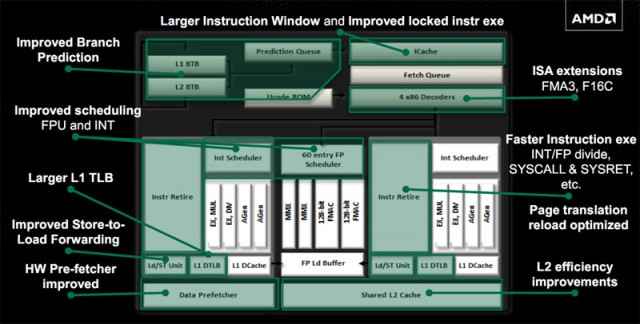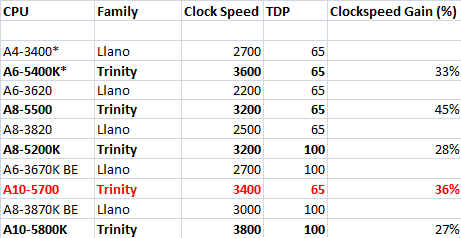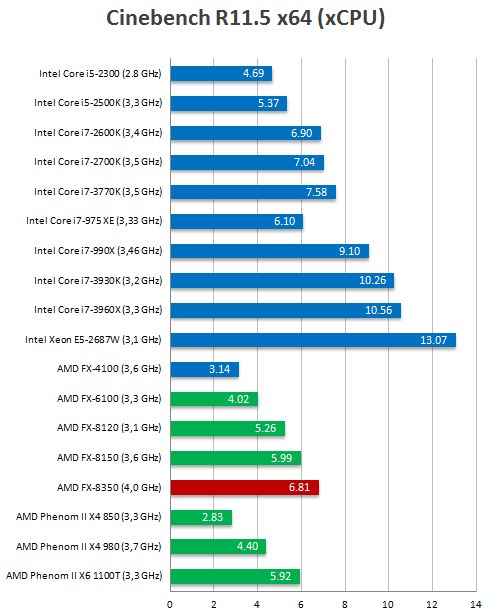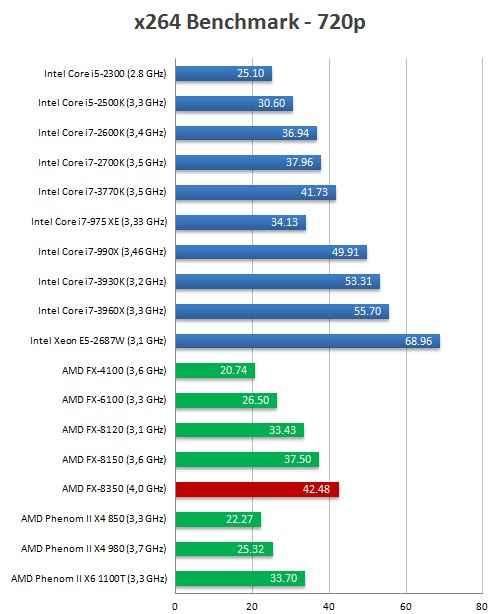AMD CPU bonanza: Trinity desktop prices, Intel’s counter, and FX-8350 performance
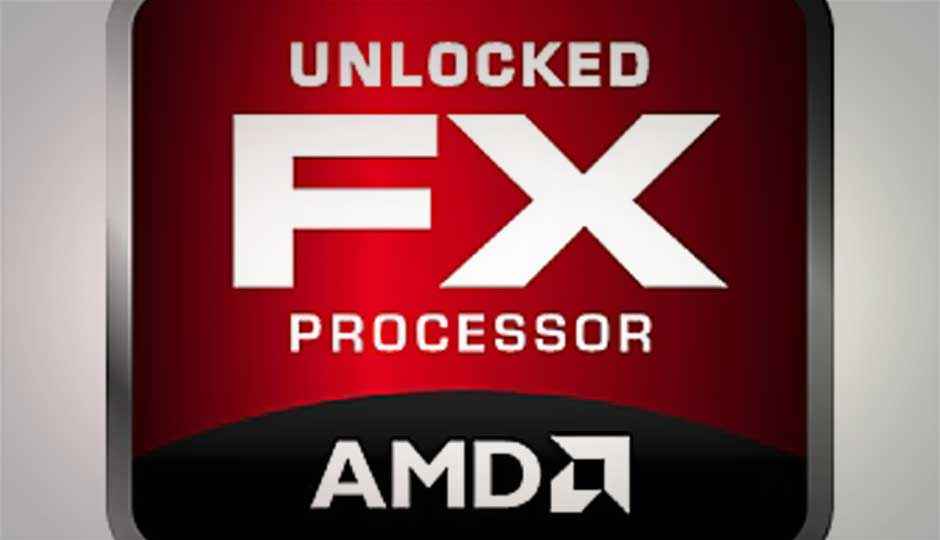
It’s been a busy weekend for CPU manufacturers. AMD’s price plans for Trinity have leaked, purported benchmarks for Vishera (the second-generation Bulldozer desktop CPU) have leaked, and Intel launched a new Core i3-3220 that’s aimed directly at the heart of Sunnyvale’s territory. Have a seat and let’s run the numbers.
First up, Trinity’s leaked pricing structure. The new chips range from $59.60 for a dual-core, 3.4GHz CPU with a 65W TDP and 1MB of L2 cache up to $130 for a 3.8GHz quad-core processor, 4MB of L2, and a 100W TDP. The $130 CPU is an unlocked Black Edition part, which should help any AMD enthusiasts who are left squeeze a bit of extra performance out of the chip.
Trinity is the first APU based on the Bulldozer core and AMD’s second mainstream APU. Its GPU is significantly more powerful than Llano’s and its CPU incorporates a number of improvements over Bulldozer. Benchmarks have proved the worth of both; mobile Trinity parts are typically 10-30% faster than their Llano equivalents. Trinity’s mobile performance should be an accurate forecast of its desktop potential; the new SKUs offer the same amount of L2 cache and a similar clock speed range.
Let’s take a look at how these new chips slot into AMD’s product mixture. In the following chart, we’ve interleaved the new Trinity SKUs with a selection of AMD’s existing Llano desktops. In choosing the latter, we opted to compare later Llanos, with correspondingly higher clock speeds at lower TDPs. AMD, however, has pulled a bit of a bait-and-switch — the company’s product database now lists the Turbo clock speed as the only clock speed on a number of APUs. This is misleading; our charts reflect the accurate base clock speeds of both current Llano and upcoming Trinity chips.
The A10-5700 is marked in red and is a special case — it’s a 65W part that’s priced between the 5200K and 5800K, but with a TDP that puts it in 65W Llano territory. The two chips denoted with an asterisk are dual-core parts.
Keep in mind that Trinity’s performance is approximately equal to Llano’s when the two are compared clock-per-clock. There are still tests where this does not hold true; the spread is wide enough that we can’t issue a blanket proclamation of what to expect. Even with this limitation, it’s clear that Trinity will improve on Llano’s price performance. The A10-5700 is particularly attractive, offering 36% more base clock speed at the same TDP. Boost clocks are even higher — the 5700 reportedly tops out at 4GHz while the 3820′s Turbo Mode runs at 2.8GHz. That’s enough to give the 5700 an even wider advantage (42.8%). The GPU is identical, but the desktop version is clocked 17% higher.
Trinity could reignite AMD’s star — if Intel doesn’t nuke it
For all that Trinity is a strong upgrade to Llano, comparisons against low-end Intel processors aren’t half so encouraging. Mobile comparisons — and remember, Trinity is a mobile variant, with higher TDPs — show Intel’s dual-core chips matching or exceeding AMD’s highest-end A8/A10 quad-core processors. This isn’t going to change much in desktops; Intel, like AMD, has higher-performing variants of all its mobile processors lined up and ready to go.
At $73, AMD’s new dual-core 5400K at 3.6GHz will compete against Intel’s Pentium G640 ($78.99, dual-core, 2.8GHz, Intel HD Graphics, no Hyper-Threading). Unless the 5400K can really overclock, that comparison isn’t going to end well. The 5800K, at $131, will go head-to-head with the new Core i3-3220, a dual-core Ivy Bridge at 3.3GHz with integrated Intel HD 2500 graphics and Hyper-Threading enabled. The 5800K’s GPU would smack the i3-3220′s around but CPU performance will inevitably go the other direction.
AMD could capitalize on its superior graphics, if the company is willing to think outside the box. Trinity’s GPU is the first integrated GPU to offer acceptable game performance in modern titles without lowering all detail levels as far as they can go. With a 17% clock speed boost on the desktop and faster RAM, that’ll only improve. Sunnyvale’s best chance to build buzz around Trinity is to offer an A10-5800K discrete GPU combo at a price OEMs and enthusiasts both find appealing. OEMs love upsell opportunities and the 5800K’s GPU will offer acceptable performance in its own right.
Potential customers also need to see more reasons to upgrade to an APU, which is where software/application support is critical. AMD’s efforts in this area have traditionally been rather weak; that needs to change if the company wants to build a long-term unique value around its own products beyond being cheaper than Intel’s. AMD’s Vision program lists a reasonable number of apps, but it’s not clear that all of them explicitly take advantage of the GPU. There’s a window of opportunity here, if Sunnyvale is bold enough to seize it.
Early Vishera performance data pretty much what we expected
Early benchmarks of an FX-8350 (4GHz base / 4.2GHz Turbo) have also leaked from OBR-Hardware, which claims to have tested both chips. The author makes no pretense of objectivity, but the figures themselves make sense. The FX-8350 is an average of 10% faster than the FX-8150. In single-threaded benchmarks, when both chips are running at their 4.2GHz Turbo, Vishera is 3-5% faster clock-for-clock. In multi-threaded benchmarks, Vishera is 10-15% faster. The graphs below are drawn from OBR-Hardware’s article:
These numbers are perfectly consistent with all the data we’ve seen on the Piledriver core to date. When AMD built Piledriver, it prioritized lowering power consumption. This, in turn, allows the chip to hit much higher frequencies. One of the FX-8150′s weaknesses was that it dissipated too much heat to spend much time in Turbo Mode; the FX-8350 is clearly spending much more time at a much higher clock speed. I’m assuming that AMD will hold its IMC (integrated memory controller) at 1.8 – 2.2GHz; the company’s products have kept to this range for years, even as Intel brought its IMC up to full processor speed on desktop SNB/IVB parts.
A 3-5% absolute IPC improvement is actually pretty good for a revision that had to be mostly finalized by the time Bulldozer launched. Vishera’s real benefit to AMD is that it gives the company’s new architecture a significant lead over older, six-core Thuban parts. A 10-15% increase in multi-core configurations will bolster AMD’s server divisions and gives Rory Read a major milestone he can point to as having occurred on his watch.
We expect Vishera’s impact on AMD’s overall revenue to be fairly small through the end of Q4. Sunnyvale is much more likely to emphasize desktop Trinity and its APU capabilities, with Vishera mainly discussed as a server upgrade. AMD’s next-generation APU, Kaveri, will use a third-generation Bulldozer core, codenamed Steamroller. Early disclosure points to a number of changes that should result in a stronger overall product, but Steamroller is still at least 8-12 months away and may never appear in a CPU-only, AM3 -compatible configuration. If the GPU component is capable of offloading general compute tasks from the CPU by then, AMD may not need an eight-core variant.
Copyright © 2010 Ziff Davis Publishing Holdings Inc

